How to potty train a dog or a cat?
Becoming a pet owner brings about many new responsibilities and challenges, potty training included. It is important to start teaching your dog or cat from the very beginning how to eliminate where you want them to. With our guide, potty training a kitten or a puppy will become an easy task.
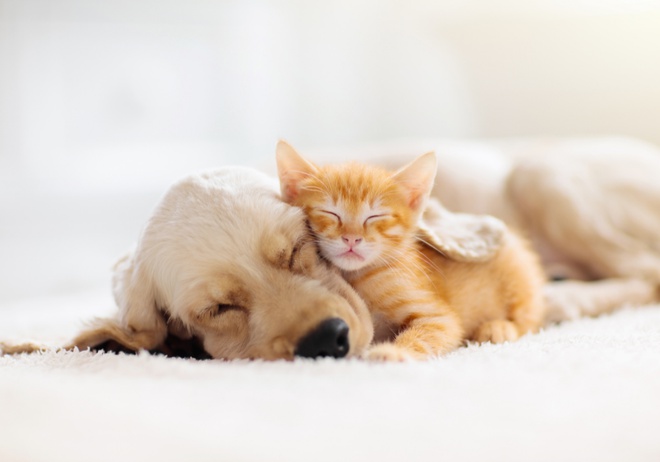
Reading time : 8 min
Potty training, also called house training, is one of the most important first steps after adopting a puppy. Although teaching your dog to eliminate in the right place and time requires patience and consistency, it is a crucial base for a good bond with your puppy as they grow. Litter box training a kitten might also seem a difficult task, but when following several simple steps, it becomes straightforward and easy to execute. In both cases, devoting your time and energy to train your pet at the beginning is worth it, as it can save you a lot of trouble in the future.
TOPICS
Different methods of potty training a dog
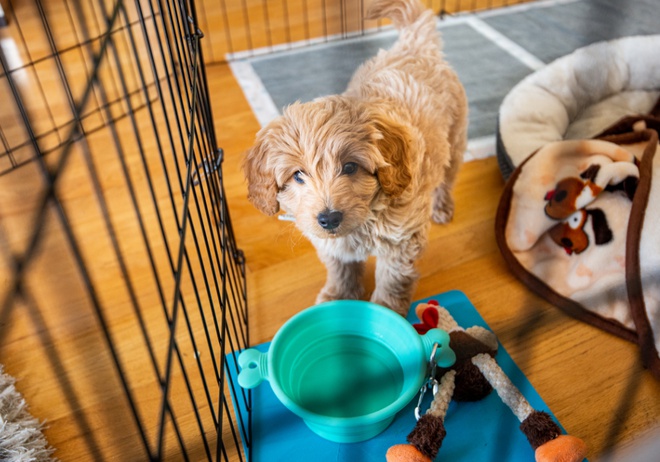
There are several methods of potty training a puppy or an adult dog, among which crate training and paper training are the most frequently chosen. As with any other types of dog training, both have pros and cons, but sticking to the common rules makes them easier and can guarantee a success.
Crate training
Crates are the most popular housetraining tool, though some owners fear accidents in a restricted space. If introduced correctly, a crate is safe and humane. Recognizing cues and guiding your puppy to a potty spot prevents accidents and creates healthy habits. Crates also prepare your dog for visits to the veterinarian or travel.
Crate size
Dogs avoid a soiled area, so crate size is essential. Too big, and accidents may occur in one corner. Too small, and the puppy feels trapped. The crate should let them lie, stand, and turn comfortably. A crate with partitions adapts as your puppy grows, helping reduce accidents indoors while reinforcing good behavior.
When to go out with the dog?
In a crate, a puppy may whine or scratch as cues to go out. Take them quickly on a leash to their potty spot. Delays can lead to accidents or confusion about where elimination is allowed. Puppies lack bladder control, so baby gates or close supervision help avoid accidents and keep training consistent.
Paper training
What is paper training?
Paper training is another method used by many owners to potty train their puppies. The use of potty pads can come in handy especially for those owners who tend to spend long hours outside, or who don’t have time to go out with their puppy-dog for a walk every time they feel the urge.
When to use paper training?
It is crucial to emphasise that paper training should not be used along with crate training, as it may confuse the puppy by allowing them to relieve themselves in specific spots at home, and thus make all the effort pointless. Because of that, this method should be used only in cases when the dogs have to be left alone and unsupervised at home, and when taking the dog outside is not an option.
10 questions to test your pet training knowledge
Do you know everything there is to know about training dogs and cats? Answer our 10 questions to find out!
Tips for a successful potty training of your dog
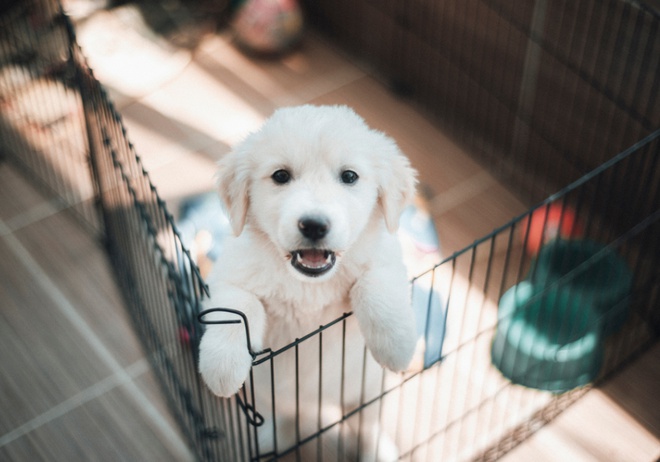
Apart from choosing the right method of potty training, it’s also crucial to stick to several tips that would make training your puppy easier, quicker, and successful.
Setting up a schedule
To ensure success, it is important to set up a training schedule for your puppy. It is not only patience and consistency that count in potty training, but also your devotion and engagement in the task. Puppies, especially the small ones, have tiny bladders, which means that they need to urinate much more often than adult dogs. It is recommended to take your puppy out on the following occasions:
- first thing in the morning,
- just before bedtime,
- after eating and drinking,
- after any vigorous activity,
- after waking up from a nap.
Controlling the diet
Controlling the diet of your new dog is an essential element of potty training, as well as a part of a housetraining schedule. Make sure to give your puppy food at specific times every day. It’s best to divide puppy’s feeding schedule into three small meals that will be easy to digest. That will not only allow you to control the times you have to take your dog out to eliminate, but it will also bring structure to the puppy’s day. The quality of the food is also extremely important. Always buy high-quality puppy food appropriate for your dog’s age.
Giving praise and rewards
Similarly to any other type of training, potty training should be based on positive reinforcement if it is to bring expected results. Every time the puppy does the right thing, reward them by either giving them a small piece of their favourite treats or lavishing them with praise and hugs. After the dog eliminates in a potty area, allow them some off-leash playtime, either in a safe outdoors area or back at home.
Make sure that they associate potty-training with fun and positive reaction from your side. For this reason, don’t scold your puppy or punish them if an accident happens – just clean it up, making sure to get rid of the scent. Be aware that this is part of the training process and embrace yourself with a lot of patience and understanding. Punishing your dog when they urinate or defecate at home might lead to behaviour problems, including anxiety.
Preparation for litter box training your cat
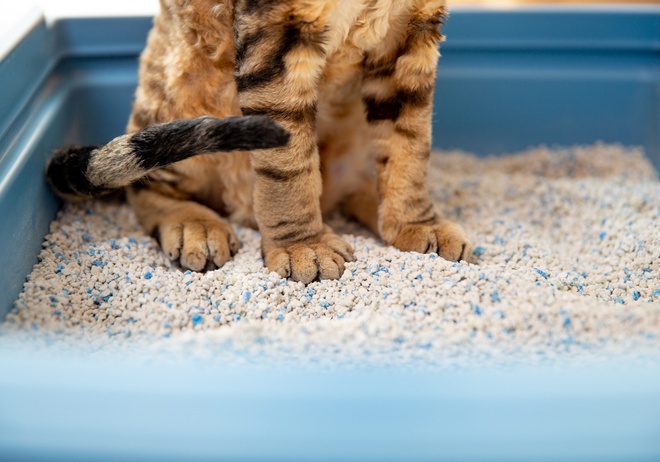
After becoming an owner of a new cat, one of the most urgent issues is litter box training your new furry friend. Although training a cat might seem a difficult task, it results fairly simple and straightforward, mostly due to cat’s nature. Most kittens are litter trained by their mothers in the first weeks of their lives. Other kittens or adult cats that were previously outdoor cats should learn to use the litter quickly, as their natural instinct will prompt them to hide the evidence of their elimination.
When to start litter training kittens
New-born kittens in the first weeks of their lives are usually taken care of by their mother, who makes sure to stimulate them to eliminate and cleans them up afterwards. During this period of life, kittens don’t need to use the litter box, and it’s recommended to start the training from the age of 4 weeks on. When adopting an older kitten or an adult cat, you can, and should, start the training as soon as the new pet arrives home.
Equipment you’ll need
You will not need elaborate equipment or expensive supplies to litter box train your cat, but it’s important to equip yourself with several essentials. Make sure to follow our advice to choose the best options both for your wallet and your cat’s preferences and health.
Litter box
It is recommended to have at least one more litter box than the number of the cats in the household. This means that when you adopt your first kitten, you should buy two litter boxes for them. You might be tempted to buy a full-size litter box straight away to avoid having to replace it once the kitten grows, but be aware that at the beginning it might be too big and thus intimidating for a small kitten.
There is also a debate among cat owners and specialists whether the uncovered littered boxes are a better choice than the covered ones. However, there is no straightforward answer to this dispute. You should observe your cat and see if they prefer an open litter box, in which they don’t feel confined, or the privacy that the covered litter boxes provide.
Type of litter
Choosing the type of litter you’ll be using might seem trivial, but it can determine the success of your training. Each cat has their own preferences, so your decision should be based on the observation of what your kitten likes. It’s best to start with a standard, unscented clumping litter, as it is usually preferred, or tolerated, by most cats. With time, you can explore other options available on the market, such as eco-friendly litters made from pine pellets, recycled newspapers or wheat and corn.
Treats and toys
Positive reinforcement training doesn’t apply only to dogs but also to cats. In order to make your cat associate using the litter box with positive things, make sure to reward them after they successfully eliminate in their box. To do this, their favourite snacks and toys will come in handy. Try to give the reward as soon as they finish using the litter box to build the association between the two things. Otherwise, the kitten might not understand the link. Under no circumstances should you punish or yell at the kitten if they make a mistake – these are part of the training process that you must be able to accept.
10 questions to test your pet training knowledge
Do you know everything there is to know about training dogs and cats? Answer our 10 questions to find out!
Steps to successful litter training
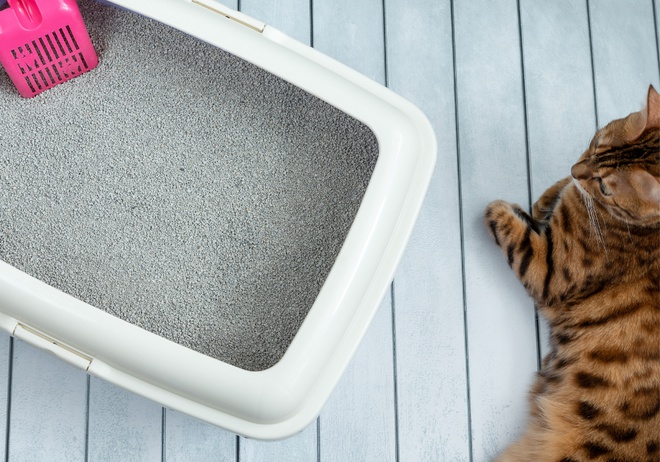
After having prepared for litter box training, there are several steps and tips you should follow in order to successfully and smoothly introduce your kitten to using the box.
Placing the litter box in the right locations
The litter box should be easy to reach but still private. Avoid hidden or noisy areas. Furthermore, it’s important to put it in a place free from distraction. Use baby gates or restricted space to guide your kitten away from a soiled area. Cats need quiet to learn cues. A consistent potty spot will help them adapt quickly. If unsure about placement, a veterinarian or trainer can advise.
Introducing the kitten to the litter box
Show your kitten the box right away. Let them sniff, explore, and paw at the litter. If needed, run your fingers through it to give simple cues. Place them in the box after meals or naps, when elimination is most likely. Use calm commands and keep them on a leash or in a crate if accidents persist.
Reward good use with praise or treats. If an accident happens, clean the soiled area well with an enzyme cleaner. Never punish, as it can cause stress or behavior issues.
Maintenance of the litter
Cats are clean animals, so scoop the box daily and replace litter if odour remains. Wash the box with mild detergent safe for pets. A dirty box may lead to repeated accidents. Consistent cleaning, patience, and guidance from a trainer or behaviorist ensure better success in training.
Troubleshooting cat’s litter box issues
Although litter box training your cat can result to be a simple task, you may sometimes encounter difficulties along the way. When your kitten stops using the box, try finding the reason behind this change and address it.
Consider changing the location of the litter box or the type of litter used. If you think your cat might need more privacy, use a covered litter box, or uncover the one you have if you notice your cat’s reluctance to confined spaces. You may also try scooping and cleaning the litter box more often.
If you see that none of your efforts brings positive results, you may need to consult your veterinarian, as such changes might be caused by parasites, urinary track problems, or other health issues.
Conclusion
Potty training is one of the first and most important trainings you will do with your pet. It can be a perfect opportunity to teach your cat or dog good habits and to establish a bond between the two of you. Using positive reinforcement method, along with your patience and consistency will be the keys to success.
Continue reading our guide
This article is a part of a complete guide on the subject. Do not miss the next chapters.
Do you know everything there is to know about training pets?
Answer our 10 questions to test your pet training knowledge.
